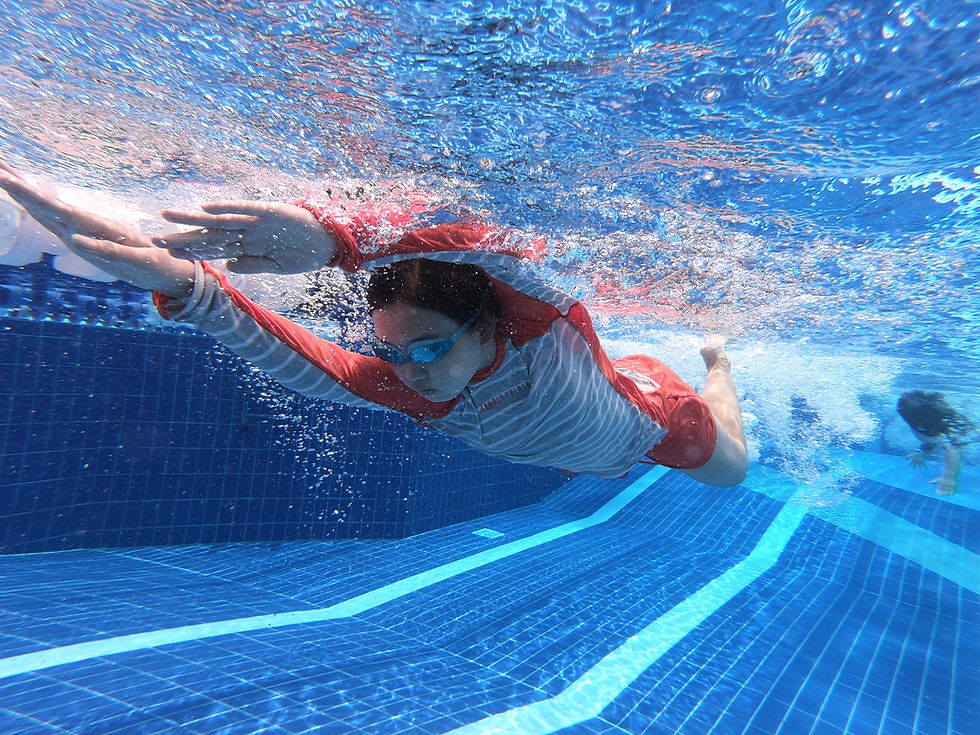Common Obstacles in Teaching Adaptive Swimming
- SG Sink Or Swim

- Jul 31
- 2 min read

Adaptive swimming provides essential water safety skills, physical activity, and confidence-building opportunities for individuals with disabilities. Whether working with swimmers who have physical, cognitive, sensory, or developmental challenges, the goal is the same: to make swimming accessible, empowering, and enjoyable for every individual.
However, teaching adaptive swimming comes with unique challenges that require thoughtful approaches, patience, and customized strategies. This article outlines the most common obstacles swim instructors face when teaching adaptive lessons—and how to address them effectively.
🧠 1. Communication Barriers
Obstacle: Many adaptive swimmers may be nonverbal, have limited language comprehension, or process instructions differently.
Solution:
Use visual cues, hand signals, or PECS cards
Demonstrate physically when possible
Keep language simple, direct, and consistent
Build a routine so swimmers know what to expect
✅ Consistency builds trust and understanding over time.
🧍♂️ 2. Limited Mobility or Physical Range
Obstacle: Swimmers with mobility impairments or muscle tone differences may struggle with traditional techniques.
Solution:
Focus on functional movement over perfection
Use aquatic equipment (floatation belts, noodles) for support
Adapt strokes based on what the swimmer can do, not what’s textbook
Reinforce core strength and balance through gentle resistance or vertical work
✅ Celebrate small wins and progress over comparison to others.
🌊 3. Fear of Water or Sensory Sensitivities
Obstacle: Some students have heightened sensitivity to noise, water temperature, or splashing—or may experience anxiety in the water.
Solution:
Introduce water gradually (start with hand or foot immersion)
Use quiet pool times or sensory-friendly hours
Allow unstructured exploration before teaching skills
Respect refusals and avoid forcing activities
✅ Creating a calming, predictable environment is key.
🔄 4. Difficulty with Transitions and Attention Span
Obstacle: Swimmers with autism or ADHD may struggle with shifting activities, staying on task, or becoming overstimulated.
Solution:
Use visual schedules or countdowns for transitions
Alternate between structured skill work and fun breaks
Keep activities short and engaging (2–5 minutes max)
Always end on a positive note to build anticipation for the next session
✅ Flexible structure works better than rigid routines.
🧑🤝🧑 5. Lack of Instructor Training or Resources
Obstacle: Many swim instructors aren’t trained in adaptive methods, and facilities may lack accessible equipment.
Solution:
Pursue certifications like Swim Angelfish, Starfish Aquatics, or Special Olympics coaching clinics
Advocate for more adaptive tools: lifts, ramps, flotation aids
Collaborate with therapists or parents for insights on the swimmer’s needs
✅ Adaptive swim instruction is a skill set—continuous learning is essential.
💡 Bonus Tips for Success in Adaptive Swimming
Build relationships — trust matters more than technique at first
Use routine-based lessons to reduce anxiety and increase participation
Allow for self-directed movement — autonomy builds confidence
Document progress — even small gains can be huge milestones
Work closely with caregivers or aides who understand the swimmer best
🏁 Final Thoughts
Adaptive swimming can be one of the most rewarding forms of instruction. Every swimmer brings unique strengths and challenges, and the role of the instructor is to meet them where they are—not to fit them into a mold. By recognizing common obstacles and applying thoughtful, flexible strategies, swim educators can help all swimmers feel confident, capable, and safe in the water.





Comments